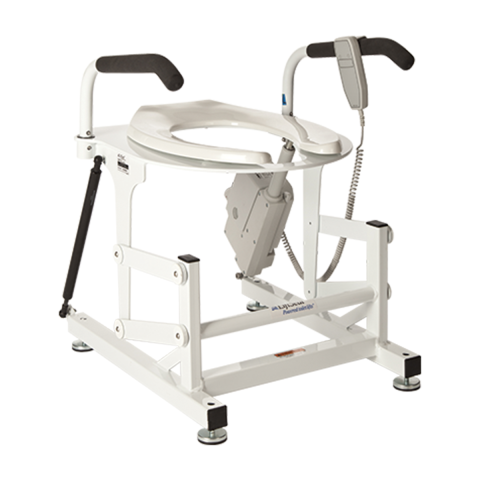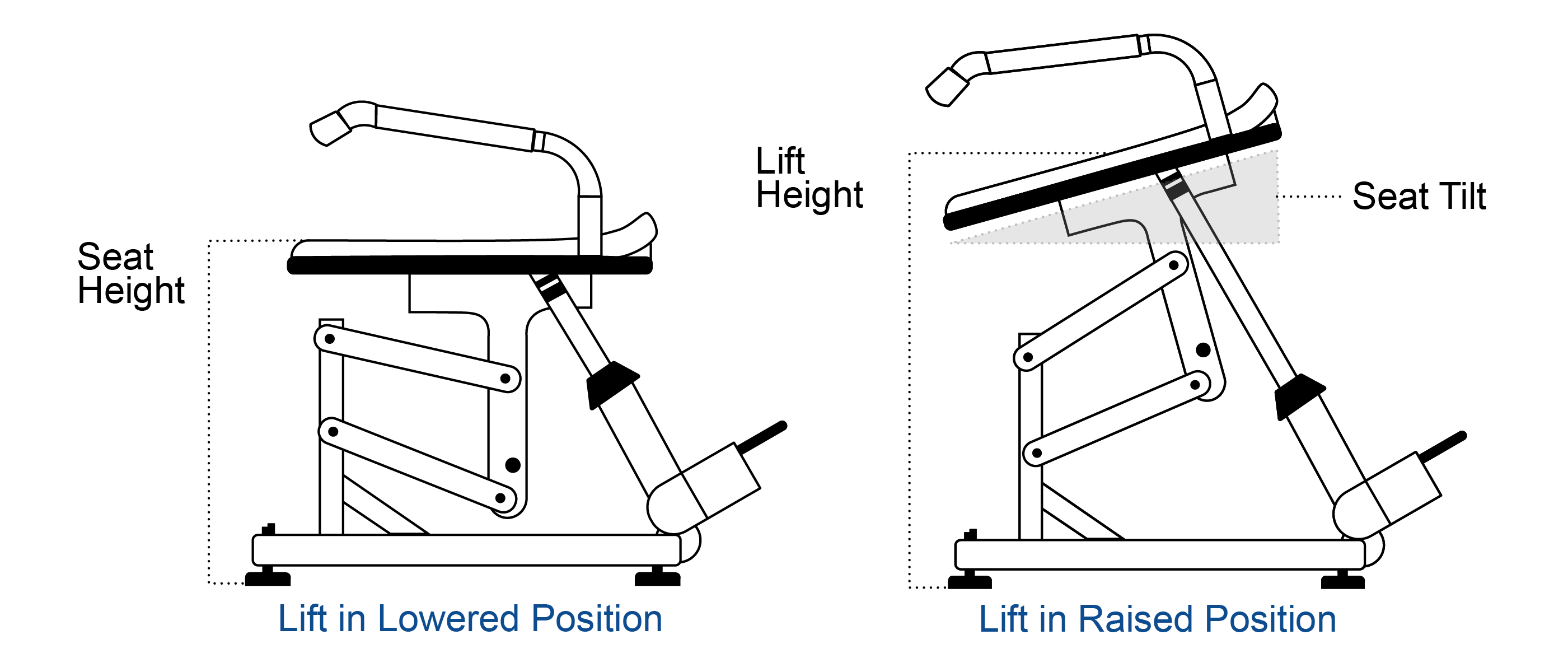Raising the Standard – Key Differences in Power Toilet Lift Technology
12/13/2024
A power toilet lift is not a product many people think about until they or a loved one have difficulty standing up from the toilet. The popular TV show Grace and Frankie, which ran for seven seasons starting in 2015, introduced the idea of power toilet lifts to a wider audience.
In the show, the character Grace has difficulty getting off the toilet and needs to call her friend Frankie for help. Determined to help her friend, Frankie goes on to invent a toilet seat called the “Rise Up” that raises the user up from the toilet, which she eventually pitches on the show Shark Tank.
While the “Rise Up” was well-received by the investors on Shark Tank, it wreaked havoc shortly after by malfunctioning and damaging the home of Grace and Frankie’s ex-husbands. Although this plot twist is humorous in the show, a malfunctioning toilet lift is no laughing matter for someone who depends on it every day.
When considering a power toilet lift in real life, you should do your research before purchasing. First, you should determine whether a power toilet lift makes sense in your situation. Second, you should consider several key characteristics to make sure you get a reputable product that you can depend on.
Do You Need a Power Toilet Lift?
Power toilet lifts are an essential tool for anyone with significant mobility restrictions. They support greater independence in the bathroom while minimizing injury risk both for users and caregivers.
Other options, such as grab bars and elevated toilet seats, may be available to people with minor mobility restrictions. These solutions do not provide as much support as a power toilet lift and should be used with caution as mobility limitations progress. It is a good idea to reassess mobility needs periodically to ensure adequate support is provided as needs change.
Key Power Toilet Lift Features
To ensure your power toilet lift works for your unique needs, you should consider several factors, focusing on compatibility and versatility.
Height
Height is one of the most important considerations when purchasing a power toilet lift. There are two different height measurements to consider: seating height and lifting height. Correct seating height is important to ensure you can comfortably sit on the lift without your feet coming off the ground. Ideal lifting height is important to ensure the lift raises you to a fully standing position.
Your height will determine what seating and lifting heights you need. Seating height is mostly a concern for short individuals, as some lifts are not low enough. Lifting height is more of a concern for tall individuals. Most lifts will go high enough to raise shorter to average-height individuals to a fully raised position, but taller individuals (6 ft and taller) will need a seat that raises at least 34 inches.
Product Spotlight:
LiftSeat offers both the shortest seating height and tallest lifting heights on the market, to accommodate the widest range of user heights (under 5.5 ft to over 6 ft tall).
- LiftSeat Independence I: Lowest seating height of 17.5 inches, suitable for individuals 5.5 ft and under
- LiftSeat Independence II and IV: Base seating height of 19.5 in, with optional long leveling feet or leg extenders to make the product suitable for individuals well above 6 ft in stature if needed

Seat Tilt
Toilet lifts have different seat tilt options: slight tilt, substantial tilt, and flat. A slight seat tilt (20 degrees or less) helps to support a more natural and comfortable sit-to-stand motion. A substantial seat tilt (greater than 20 degrees) is not ideal, as it can lead to the user sliding forward when using the lift. There are several lifts currently on the market that have over a 30-degree tilt, which is greater than the maximum recommended angle for playground slides designed for young children.1
Some individuals may prefer a flat seating surface, and it’s hard to know which you will prefer until you’ve tried both. Look for a lift that offers both a slight tilt and no tilt option to ensure you have the flexibility to adjust depending on your personal preference.
Product Spotlight:
All LiftSeat models offer the option of tilt or no-tilt. The tilt angle is a comfortable 15 degrees, aiding in standing while minimizing the sensation and risk of sliding forward.
LiftSeat Independence I, LiftSeat Independence II and LiftSeat Independence IV all have tilt and no-tilt options.
Rise and Lower Time
In Grace and Frankie, one of Frankie’s early “Rise Up” prototypes hilariously launches the test dummy across the room. In real life, no toilet lift would expel a user like an ejection seat. All major lift manufacturers make lifts that slowly raise the user up, so you don’t need to be worried about being thrown across the room.
What you do need to consider when choosing a lift, is whether a lift rises/lowers too slowly. If a lift lowers too slowly, you might not make it down to the toilet time. If the lift rises too slowly, it puts more strain on your leg muscles. In some cases, it may also cut off blood flow and cause your legs to fall asleep. A rise time between 10-15 seconds is ideal.
Product Spotlight:
All LiftSeat units have an ideal rise/lower time of 12-14 seconds, to minimize risk of accidents and maximize ease-of-use.
- LiftSeat Independence I: 12-second rise time
- LiftSeat Independence II: 14-second rise time
- LiftSeat Independence IV: 14-second rise time
Ease of Installation & Portability
Toilet lifts are available in two main installation styles – attached and free-standing. Attached models, which are integrated into your existing toilet and replace your existing toilet seat, require a bit more work to install. This style of lift typically has a lower weight rating and is not as adjustable as a free-standing lift, meaning it may not work for heavier and/or taller individuals.
Free-standing lifts, which fit over the existing toilet without any need for tools or modification, are a more popular option. Lift width can vary, so it’s important to carefully measure your bathroom space to make sure the lift fits. Some models are also designed to be mobile, so they can be used bedside as well.
Product Spotlight
All LiftSeat models are free-standing, easy to install, and compact enough to fit in nearly every bathroom space (even non-standard sized). They can also be fitted with wheels and a commode bucket for bedside use.
- LiftSeat Independence I: 21.5 inches wide and can be converted for bedside use
- LiftSeat Independence II: 21.5 inches wide and can be converted for bedside use
- LiftSeat Independence IV: 23 inches wide and can be converted for bedside use
Bidet Compatibility
A bidet is an important feature for toilet lifts. Many individuals who need assistance getting on and off the toilet also need assistance wiping. Not all toilet lifts offer a bidet option, and some are only available with a built-in bidet. If you’re not sure whether you need a bidet, you should consider a lift that can work with or without one so you can add one later if your needs change.
Product Spotlight
All LiftSeat models can be modified with an electric washing bidet. There is currently only one other standalone toilet lift product that offers a bidet option, but it costs over $1000 more than the cost of any LiftSeat model with the added bidet accessory.
LiftSeat products can be modified with a wide range of accessories to maximize individual comfort and utility.
Deciding What’s Right for You
There are numerous power toilet lift products to choose from today. You don’t have to be an expert in power toilet lift technology to choose the best lift, you just need to do your research and consider the key factors above to get the right lift for your unique needs.
If you are still unsure what lift is right for you, you can always contact the experts at LiftSeat (who have helped thousands of people find their perfect lift). They will work with you to learn about your situation and identify a lifting solution right for your needs.
References:
- Office of Compliance & Field Operations, Public Playground Safety Handbook (2015). Bethesda, MD; U.S. Consumer Product Safety Commission. Retrieved June 26, 2023, from https://www.cpsc.gov/s3fs-public/325.pdf
This content is not intended to be a substitute for professional medical advice, diagnosis, or treatment. Always seek the advice of your physician or other qualified health provider with any questions you may have regarding a medical condition.